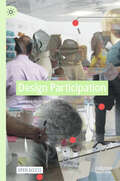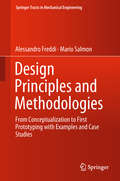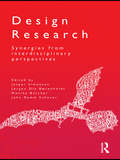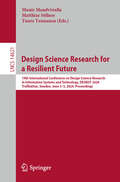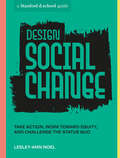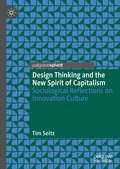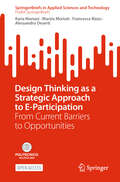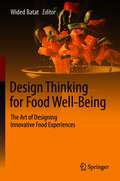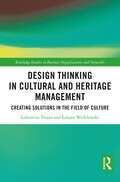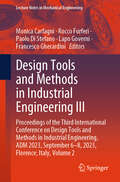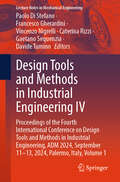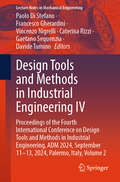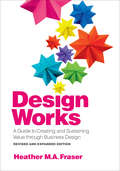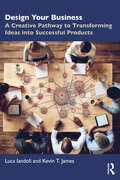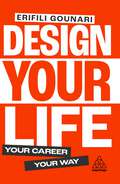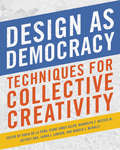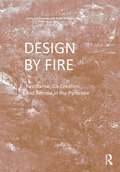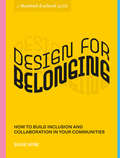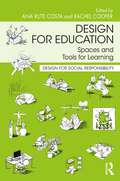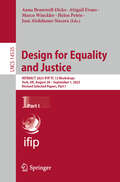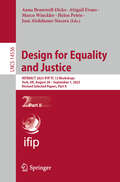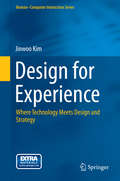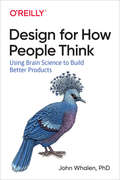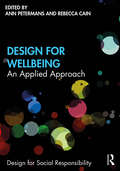- Table View
- List View
Design Management: Organisation and Marketing Perspectives
by Sotiris T. LalaounisPlaced at the nexus between marketing and organisational studies, this book breaks a new ground on the intersection of these two disciplines with design management. With the latest marketing thinking assigning greater emphasis on organisations co-creating value with consumers and other stakeholders by placing them at the heart of the product/service development process, it has never been more important to integrate marketing and organisational perspectives into design management. This text explores the importance of managing design strategies, design processes, and design implementation in a way that it puts the human and the society at the centre, contributing to organisational success, customer gratification, and social welfare. Drawing from a variety of scholarly research and personal commercial insights, this book integrates key concepts of marketing, innovation, and design, to provide an in-depth discussion of the subject of design management. With end-of-chapter exercises, case studies, and reflective insights along with online teaching materials, Design Management: Organisation and Marketing Perspectives is an essential text for students in design management, marketing, and innovation, or for anyone interested in gaining an in-depth understanding of how design can be successfully managed in order to generate the best answers to contemporary global challenges.
Design Participation
by Sampsa HyysaloThis open access book Design Participation presents doable and demonstrated ways by which design can become a major contributor to social and environmental change. This entails a shift from seeking to define solutions to opening spaces in which others—activists, entrepreneurs, civil servants, neighborhood communities, politicians (and so on) —can effectively elaborate on and find (re)solutions to the matters they are facing. It is now time to pursue design participation for real: in earnest, skillfully and for real problems. Building on a twenty-year research program, Design Participation shows that participation matters and provides an encompassing resource for understanding the matters of participation: how to think, reflect, plan and work in design participation in different settings and for different issues.
Design Principles and Methodologies: From Conceptualization to First Prototyping with Examples and Case Studies (Springer Tracts in Mechanical Engineering)
by Alessandro Freddi Mario SalmonThis book introduces readers to the core principles and methodologies of product development, and highlights the interactions between engineering design and industrial design. It shows to what extent the two cultures can be reconciled, and conversely what makes each of them unique. Although the semantic aspect is fundamental in industrial design, while the functional aspect is essential for the industrial product, the interaction between the two worlds is strategically vital. Design is also a strategic problem-solving process that drives innovation, builds business success and leads to better quality of life through innovative products, systems, services and experiences. The book connects product development with the concepts and strategies of innovation, recognizing that product design is a complex process in which invention, consumers’ role, industrial technologies, economics and the social sciences converge. After presenting several examples of artifacts developed up to the conceptual phase or built as prototypes, the book provides a case study on a packaging machine, showcasing the principles that should underlie all design activities, and the methods that must be employed to successfully establish a design process. The book is primarily targeted at professionals in the industry, design engineers and industrial designers, as well as researchers and students in design schools, though it will also benefit any reader interested in product design.
Design Research: Synergies from Interdisciplinary Perspectives
by Jesper SimonsenDesign Research is a new interdisciplinary research area with a social science orientation at its heart, and this book explores how scientific knowledge can be put into practice in ways that are at once ethical, creative, helpful, and extraordinary in their results. In order to clarify the common aspects – in terms of features and approaches – that characterize all strands of research disciplines addressing design, Design Research undertakes an in-depth exploration of the social processes involved in doing design, as well as analyses of the contexts for design use. The book further elicits ‘synergies from interdisciplinary perspectives’ by discussing and elaborating on differing academic perspectives, theoretical backgrounds, and design concept definitions, and evaluating their unique contribution to a general core of design research. This book is an exciting contribution to this little explored field, and offers a truly interdisciplinary approach to the treatment of design and the design process. It is valuable reading for students in disciplines such as design studies and theory, participatory design, informatics, arts based education, planning, sociology, and interdisciplinary programmes in humanities and technology.
Design Science Research for a Resilient Future: 19th International Conference on Design Science Research in Information Systems and Technology, DESRIST 2024, Trollhättan, Sweden, June 3–5, 2024, Proceedings (Lecture Notes in Computer Science #14621)
by Tuure Tuunanen Munir Mandviwalla Matthias SöllnerThis book constitutes the proceedings of the 19th International Conference on Design Science Research in Information Systems and Technology, DESRIST 2024, which was held in Trollhättan, Sweden, during June 3–5, 2024. The 30 full papers presented in this book were carefully reviewed and selected from 69 submissions. The papers are divided into the following topical sections: DSR for a resilient world (theme track); general track; DSR methods and education; DSR in practice; and emerging topics in DSR.
Design Social Change: Take Action, Work toward Equity, and Challenge the Status Quo (Stanford d.school Library)
by Stanford d.school Lesley-Ann NoelDiscover design strategies for using your own unique social identities and experiences as inspiration to challenge the status quo and create the kind of lasting change that leads to greater equity and social justice, from Stanford University's d.school.Who are you? What motivates you as a changemaker? What forces are preventing you (and others) from thriving? These questions are essential to the work of creating social change, and they are exactly what Design Social Change asks you to explore.Designer and design educator Lesley-Ann Noel shares the essential design strategies for making a lasting impact. This work starts with knowing yourself and builds outward into making change in your community and the larger world. Design Social Change gives you tools to tailor your approach to design, taking into account your history, personality, ethics, and goals for a better future.The strategies for change are based on equity and fairness, understanding your own role in these systems of both justice and inequity. These strategies demonstrate how to use anger, joy, and empathy as inspiration for understanding what people need to thrive. Using the tools of design, these new approaches will help you craft projects that are relevant to you and create more just, equitable futures. The time is always right to work toward a fair and just society.
Design Thinking and the New Spirit of Capitalism: Sociological Reflections on Innovation Culture
by Tim SeitzAn ethnographic study on Design Thinking, this book offers profound insights into the popular innovation method, centrally exploring how design thinking’s practice relates to the vast promises surrounding it. Through a close study of a Berlin-based innovation agency, Tim Seitz finds both mundane knowledge practices and promises of transformation. He unpacks the relationships between these discourses and practices and undertakes an exploratory movement that leads him from practice theory to pragmatism. In the course of this movement, Seitz makes design thinking understandable as a phenomenon of what Boltanski and Chiapello described as the “new spirit of capitalism”—that is, an ideological structure that incorporates criticism and therefore strengthens capitalism.
Design Thinking as a Strategic Approach to E-Participation: From Current Barriers to Opportunities (SpringerBriefs in Applied Sciences and Technology)
by Marzia Mortati Francesca Rizzo Ilaria Mariani Alessandro DesertiThis open access book examines how the adoption of Design Thinking (DT) can support public organisations in overcoming some of the current barriers in e-participation. Scholars have discussed the adoption of technology to strengthen public engagement through e-participation, streamline and enhance the relationship between government and society, and improve accessibility and effectiveness. However, barriers persist, necessitating further research in this area. By analysing e-participation barriers emerging from the literature and aligning them with notions in the DT literature, this book identifies five core DT practices to enhance e-participation: (i) Meaning creation and sense-making, (ii) Publics formation, (iii) Co-production, (iv) Experimentation and prototyping, and (v) Changing organisational culture. As a result, this book provides insights into enhancing tech-aided public engagement and promoting inclusivity for translating citizen input into tangible service implementations. The book triangulates qualitative analysis of relevant literature in the fields of e-participation and DT with knowledge from European projects experimenting with public participation activities implying experimentation with digital tools. This research aims to bridge the gap between theoretical frameworks and practical application, ultimately contributing to more effective e-participation and digital public services.
Design Thinking for Food Well-Being: The Art of Designing Innovative Food Experiences
by Wided BatatHow can we design innovative food experiences that enhance food pleasure and consumer well-being? Through a wide variety of empirical, methodological, and theoretical contributions, which examine the art of designing innovative food experiences, this edited book explores the relationship between design thinking, food experience, and food well-being. While many aspects of food innovation are focused on products' features, in this book, design thinking follows an experiential perspective to create a new food innovation design logic that integrates two aspects: consumer food well-being and the experiential pleasure of food. It integrates a holistic perspective to understand how designing innovative food experiences, instead of food products, can promote healthy and pleasurable eating behaviors among consumers and help them achieve their food well-being. Invaluable for scholars, food industry professionals, design thinkers, students, and amateurs alike, this book will define the field of food innovation for years to come.
Design Thinking in Cultural and Heritage Management: Creating Solutions in the Field of Culture (ISSN)
by Lubomira Trojan Łukasz WróblewskiThe ability to discover and respond to societal needs in the field of culture requires an integrated, interdisciplinary, and cross-sectoral approach. Such a holistic view is offered by the design thinking method, which has been extracted from the field of design and could be applied also in the sphere of culture. Interdisciplinarity and consideration of users' needs are characteristics of contemporary design and can be a significant support when faced with the challenges of cultural heritage management. The abovementioned factors act as the premise behind undertaking an analysis of the possibility of adapting the design thinking method to the management of intangible cultural heritage, and to develop a model of the design thinking process for this area. This research volume is the first comprehensive study of the application of the design thinking method to cultural management, especially management of the intangible cultural heritage. It asserts that design thinking can bring numerous benefits to organizations involved in the management of intangible cultural heritage and to its depositories. It will be of interest to researchers and academics in the fields of public and nonprofit management, strategic management, and value creation in the field of culture; students of design for culture and heritage; and practitioners in cultural management.
Design Tools and Methods in Industrial Engineering III: Proceedings of the Third International Conference on Design Tools and Methods in Industrial Engineering, ADM 2023, September 6–8, 2023, Florence, Italy, Volume 2 (Lecture Notes in Mechanical Engineering)
by Francesco Gherardini Rocco Furferi Lapo Governi Paolo Di Stefano Monica CarfagniThis book gathers original peer-reviewed papers reporting on innovative methods and tools in design, modeling, simulation and optimization, and their applications in engineering design, manufacturing, and other relevant industrial sectors. Based on contributions to the Third International Conference on Design Tools and Methods in Industrial Engineering, ADM 2023, held on September 6–8, 2023, in Florence, Italy, and organized by the Italian Association of Design Methods and Tools for Industrial Engineering, and the Department of Industrial Engineering of the University of Florence, this second volume of a 2-volume set focuses on interdisciplinary topics in design, such as human body acquisition and modelling, human factors and user-centered design, digital factories, and design methods for different engineering applications. All in all, this book provides academics and professionals with a timely overview and extensive information on trends and technologies in industrial design and manufacturing.
Design Tools and Methods in Industrial Engineering IV: Proceedings of the Fourth International Conference on Design Tools and Methods in Industrial Engineering, ADM 2024, September 11–13, 2024, Palermo, Italy, Volume 1 (Lecture Notes in Mechanical Engineering)
by Caterina Rizzi Vincenzo Nigrelli Francesco Gherardini Paolo Di Stefano Gaetano Sequenzia Davide TuminoThis book gathers original peer-reviewed papers reporting on innovative methods and tools in design, modeling, simulation and optimization, and their applications in engineering design, manufacturing, and other relevant industrial sectors. Based on contributions to the Fourth International Conference on Design Tools and Methods in Industrial Engineering, ADM 2024, held on September 11–13, 2024, in Palermo, Italy, and organized by the Italian Association of Design Methods and Tools for Industrial Engineering, and the Department of Engineering of the University of Palermo, this first volume of a 2-volume set focuses on advances in design for additive manufacturing, product design and engineering, design for sustainability and ecoDesign, experimental methods in product development and integrated methods for product and process design. Further topics include: simulation, analysis and optimization, design of collaborative and soft robots, geometrical product specification and tolerancing, and design methods for mobility. This book provides academics and professionals with a timely overview and extensive information on trends and technologies in industrial design and manufacturing.
Design Tools and Methods in Industrial Engineering IV: Proceedings of the Fourth International Conference on Design Tools and Methods in Industrial Engineering, ADM 2024, September 11–13, 2024, Palermo, Italy, Volume 2 (Lecture Notes in Mechanical Engineering)
by Caterina Rizzi Vincenzo Nigrelli Francesco Gherardini Paolo Di Stefano Gaetano Sequenzia Davide TuminoThis book gathers original peer-reviewed papers reporting on innovative methods and tools in design, modeling, simulation and optimization, and their applications in engineering design, manufacturing, and other relevant industrial sectors. Based on contributions to the Fourth International Conference on Design Tools and Methods in Industrial Engineering, ADM 2024, held on September 11–13, 2024, in Palermo, Italy, and organized by the Italian Association of Design Methods and Tools for Industrial Engineering, and the Department of Engineering of the University of Palermo, this second volume of a 2-volume set focuses on engineering methods in medicine, human factors and ergonomics, and reverse engineering. Further topics include: digital acquisition, image processing and inspection, virtual and augmented reality, virtual prototyping and digital twin, as well as engineering education, and knowledge and product data management. All in all, this book provides academics and professionals with a timely overview and extensive information on trends and technologies in industrial design and manufacturing.
Design Works: A Guide to Creating and Sustaining Value through Business Design, Revised and Expanded Edition (G - Reference, Information and Interdisciplinary Subjects)
by Heather M. FraserDesign Works is a second-edition collection of best practices that serves as a leader’s guide to driving innovation within the enterprise through the strategic and design-inspired practice of Business Design. It is well recognized that enterprise success requires ongoing innovation to create new value and sustain success. That requires a disciplined integration of exploration, sound strategic decision-making and leadership at all levels of the enterprise. While the resurgence of design thinking has proven to catalyze fresh thinking, it can fall short if not fully integrated with the business strategy of the enterprise, mindful stakeholder engagement and the evolution of enterprise management systems. This book builds on the fundamental principles of the first edition of Design Works: How to Tackle Your Toughest Innovation Challenges through Business Design. It expands on how to effectively navigate progress through strategy integration, effective stakeholder engagement and blending design-inspired practices with analytics to build a compelling business case for investment in value-creating efforts. Like the first edition, it includes valuable frameworks, inspiring stories and practical tools to drive growth and innovation in any type of organization. Clear principles for leading innovation draw from others’ experience to help make the most of enterprise talent and resources. New methodologies hone and build on the repertoire of tools in the first edition. New stories provide insights into how a variety of organizations have leveraged the principles and practices of Business Design.
Design Your Business: A Creative Pathway to Transforming Ideas into Successful Products
by Luca Iandoli Kevin T. JamesThis actionable and lively guide helps aspiring entrepreneurs to acquire a designer’s mindset to transform ideas into successful products, and designers and technologists to identify entrepeneurial opportunities through a unique mix of product and business development toolkits.Unlike other books focusing either downstream on the launch of a new venture or upstream on ideation and the acquisition of an entrepreneurial mindset, Design Your Business helps innovators to cross the chasm between attractive ideas and actual products, a crucial test in any entrepreneurial endeavor and one which most innovative ideas do not pass. Throughout the book, readers will learn about methods, steps, and resources to unleash their creativity, understand users’ needs, build and test prototypes, and design beautiful products. At the end of this design journey, readers will find an essential business toolkit including business model design, intellectual property protection, funding, and development of effective communication skills that will help them to lay the foundation of a successful venture built around a successful product.This book will become an essential and thought-provoking resource for aspiring entrepreneurs, makers, students of entrepreneurship and new venture creation, and professionals seeking to adopt a design mindset and agile project management in their projects and organizations.Slides and teaching materials based on this book are curated from the authors and available for free at this link: https://elegantdesignthinking.com/category/learning-resources/
Design Your Life: Your Career, Your Way
by Erifili GounariWe don't have to conform to traditional ways of working. Uncover how to build a successful career on your own terms and develop the skills you need for the future with Design Your Life. Why settle with a conventional career path when you can build a future on your own terms? With innovations such as side gigs and personal branding, you can craft your own, authentic future. Design Your Life uncovers the key skills and strategies that will allow you to build a successful career as a young professional. In this book, Gen Z business leader and expert Erifili Gounari draws upon original research and first-hand interviews to uncover how you can thrive and find success in this new world of work, creating a career with flexibility and ownership.
Design as Democracy: Techniques for Collective Creativity
by Jeffrey Hou David de la Pena Diane Jones Allen Randolph T. Hester Jr. Laura J. Lawson Marcia J. McNallyHow can we design places that fulfill urgneeds of the community, achieve environmental justice, and inspire long-term stewardship? By bringing community members to the table, we open up the possibility of exchanging ideas meaningfully and transforming places powerfully. Collaboration like this is hands-on democracy in action. It's up close. It's personal. For decades, participatory design practices have helped enliven neighborhoods and promote cultural understanding. Yet, many designers still rely on the same techniques that were developed in the 1950s and 60s. These approaches offer predictability, but hold waning promise for addressing currand future design challenges. Design as Democracy: Techniques for Collective Creativity is written to reinvigorate democratic design, providing inspiration, techniques, and case stories for a wide range of contexts.Edited by six leading practitioners and academics in the field of participatory design, with nearly 50 contributors from around the world, Design as Democracy shows how to design with communities in empowering and effective ways. The flow of the book's nine chapters reflects the general progression of community design process, while also encouraging readers to search for ways that best serve their distinct needs and the culture and geography of diverse places. Each chapter presents a series of techniques around a theme, from approaching the initial stages of a project, to getting to know a community, to provoking political change through strategic thinking. Readers may approach the book as they would a cookbook, with recipes open to improvisation, adaptation, and being created anew.Design as Democracy offers fresh insights for creating meaningful dialogue between designers and communities and for transforming places with justice and democracy in mind.
Design by Fire: Resistance, Co-Creation and Retreat in the Pyrocene
by Emily Schlickman Brett MilliganAcross the world, the risks of wildfires are increasing and expanding. Due to past and current human actions, we dwell in the age of fire – the Pyrocene – and the many challenges and climate adaptation questions it provokes. Exploring our past and current relationships with fire, this book speculates on the pyro futures yet to be designed and cared for. Drawing upon fieldwork, mapping, drone imagery, and interviews, this publication curates 27 global design case studies within the vulnerable and dynamic wildland-urban interface and its adjacent wildlands. The book catalogs these examples into three approaches: those that resist the creative and transformative power of fire and forces of landscape change, those that embrace and utilize those forces, and those that intentionally try to retreat and minimize human intervention in fire-prone landscapes. Rather than serving as a book of neatly packaged solutions, it is a book of techniques to be considered, tested, and evaluated in a time of fire.
Design for Belonging: How to Build Inclusion and Collaboration in Your Communities (Stanford d.school Library)
by Stanford d.school Susie WiseA practical, illustrated guide to using the tools of design to create feelings of inclusion, collaboration, and respect in groups of any type or size—a classroom, a work team, an international organization—from Stanford University's d.school.&“This is a beautiful book. Wise has applied the gift and imagination and lenses of the d.school to one of our most precious questions: how to create belonging.&”—Priya Parker, author of the Art of Gathering and host of the New York Times podcast Together ApartBelonging brings out the best in everyone. Whether you&’re a parent, teacher, community organizer, or leader of any sort, your group is unlikely to thrive if the individuals don&’t feel welcomed, included, and valued for who they are.The good news is that you can use design to create feelings of inclusion in your organization: rituals that bring people together, spaces that promote calm, roles that create a sense of responsibility, systems that make people feel respected, and more. You can&’t force feelings, but in Design for Belonging, author and educator Susie Wise explains how to use simple levers of design to set the stage for belonging to emerge. For example, add moveable furniture to a meeting space to customize for your group size; switch up the role of group leader regularly to increase visibility for everyone; or create a special ritual for people joining or leaving your organization to welcome fresh perspectives and honor work well done.Inspiration and stories from leaders and scholars are paired with frameworks, tools, and tips, providing an opportunity to try on different approaches. By the end of the book, you&’ll be able to spot where a greater sense of belonging is needed and actively shape your world to cultivate it—whether it&’s a party, a high-stakes meeting, or a new national organization.
Design for Education: Spaces and Tools for Learning (ISSN)
by Ana Rute CostaThis book charts the impact of design on education, specifically focusing on how design can shape the spaces and tools for learning.This edited collection brings together the work of designers, architects, engineers, professionals, educators, and researchers, and presents a series of case studies and research developed from across Europe, North America, South America, Africa, Australia, and Asia. The book provides the tools to develop innovative approaches to design for education, and illustrates the conversation and action required to foster socially responsible design for education. As the contributions show, we must look at education as an input and output of a complex system, and we need to adopt an interdisciplinary multiple stakeholder approach, bringing together experts from a range of different fields and backgrounds as a cohesive strategy to improve future learning and teaching environments.Providing guidance and a theoretical framework for designing spaces and tools for learning, this book will be a useful resource for design and architecture students, as well as practitioners, educational researchers, educational practitioners, policymakers, and behaviour and built environment researchers.
Design for Equality and Justice: INTERACT 2023 IFIP TC 13 Workshops, York, UK, August 28 – September 1, 2023, Revised Selected Papers, Part I (Lecture Notes in Computer Science #14535)
by Marco Winckler José Abdelnour-Nocera Helen Petrie Anna Bramwell-Dicks Abigail EvansThis volume presents a series of revised papers selected from workshops that took place during the 19th IFIP TC13 International Conference on Human-Computer Interaction, INTERACT 2023, held August 28th to September 1st 2023 at the University of York, York, UK. The 54 revised full papers and 21 short papers presented were carefully selected from a competitive selection process. INTERACT 2023 presents the following workshops: WG 13.2 – Human-Centered Software Engineering: Rethinking the Interplay of Human–Computer Interaction and Software Engineering in the Age of Digital Transformation. WG 13.3 – Designing Technology for Neurodivergent Self-Determination: Challenges and Opportunities. WG 13.4/2.7 – HCI-E2-2023: Second IFIP WG 2.7/13.4 Workshop on HCI Engineering Education. WG 13.5 – On Land, at Sea, and in the Air: Human-Computer Interaction in Safety-Critical Spaces of Control. WG 13.6 – Sustainable Human-Work Interaction Designs. WG 13.8 – HCI for Digital Democracy and Citizen Participation. WG 13.10 – Designing for Map-based Interfaces and Interactions. Algorithmic affordances in recommender interfaces. Intelligence Augmentation: Future Directions and Ethical Implications in HCI. Interacting with Assistive Technology (IATech) Workshop. Re-Contextualizing Built Environments: Critical & Inclusive HCI Approaches for Cultural Heritage.
Design for Equality and Justice: INTERACT 2023 IFIP TC 13 Workshops, York, UK, August 28 – September 1, 2023, Revised Selected Papers, Part II (Lecture Notes in Computer Science #14536)
by Marco Winckler José Abdelnour-Nocera Helen Petrie Anna Bramwell-Dicks Abigail EvansThis volume presents a series of revised papers selected from workshops that took place during the 19th IFIP TC13 International Conference on Human-Computer Interaction, INTERACT 2023, held August 28th to September 1st 2023 at the University of York, York, UK. The 54 revised full papers and 21 short papers presented were carefully selected from a competitive selection process. INTERACT 2023 presents the following workshops: WG 13.2 – Human-Centered Software Engineering: Rethinking the Interplay of Human–Computer Interaction and Software Engineering in the Age of Digital Transformation. WG 13.3 – Designing Technology for Neurodivergent Self-Determination: Challenges and Opportunities. WG 13.4/2.7 – HCI-E2-2023: Second IFIP WG 2.7/13.4 Workshop on HCI Engineering Education. WG 13.5 – On Land, at Sea, and in the Air: Human-Computer Interaction in Safety-Critical Spaces of Control. WG 13.6 – Sustainable Human-Work Interaction Designs. WG 13.8 – HCI for Digital Democracy and Citizen Participation. WG 13.10 – Designing for Map-based Interfaces and Interactions. Algorithmic affordances in recommender interfaces. Intelligence Augmentation: Future Directions and Ethical Implications in HCI. Interacting with Assistive Technology (IATech) Workshop. Re-Contextualizing Built Environments: Critical & Inclusive HCI Approaches for Cultural Heritage.
Design for Experience
by Jinwoo KimPresents a strategic perspective and design methodology that guide the process of developing digital products and services that provide 'real experience' to users. Only when the material experienced runs its course to fulfilment is it then regarded as 'real experience' that is distinctively senseful, evaluated as valuable, and harmoniously related to others. Based on the theoretical background of human experience, the book focuses on these three questions: How can we understand the current dominant designs of digital products and services? What are the user experience factors that are critical to provide the real experience? What are the important HCI design elements that can effectively support the various UX factors that are critical to real experience? Design for Experience is intended for people who are interested in the experiences behind the way we use our products and services, for example designers and students interested in interaction, visual graphics and information design or practitioners and entrepreneurs in pursuit of new products or service-based start-ups.
Design for How People Think: Using Brain Science to Build Better Products
by John WhalenUser experience doesn’t happen on a screen; it happens in the mind, and the experience is multidimensional and multisensory. This practical book will help you uncover critical insights about how your customers think so you can create products or services with an exceptional experience.Corporate leaders, marketers, product owners, and designers will learn how cognitive processes from different brain regions form what we perceive as a singular experience. Author John Whalen shows you how anyone on your team can conduct "contextual interviews" to unlock insights. You’ll then learn how to apply that knowledge to design brilliant experiences for your customers.Learn about the "six minds" of user experience and how each contributes to the perception of a singular experienceFind out how your team—without any specialized training in psychology—can uncover critical insights about your customers’ conscious and unconscious processesLearn how to immediately apply what you’ve learned to improve your products and servicesExplore practical examples of how the Fortune 100 used this system to build highly successful experiences
Design for Wellbeing: An Applied Approach (Design for Social Responsibility)
by Ann Petermans Rebecca CainDesign for Wellbeing charts the development and application of design research to improve the personal and societal wellbeing and happiness of people. It draws together contributions from internationally leading academics and designers to demonstrate the latest thinking and research on the design of products, technologies, environments, services and experiences for wellbeing. Part I starts by conceptualising wellbeing and takes an in-depth look at the rise of the design for wellbeing movement. Part II then goes on to demonstrate design for wellbeing in practice through a broad range of domains from products and environments to services. Among others, we see emerging trends in the design of interiors and urban spaces to support wellbeing, designing to enable and support connectedness and social interaction, and designing for behaviour change to tackle unhealthy eating behaviour in children. Significantly, the body of work on subjective wellbeing, design for happiness, is increasing, and several case studies are provided on this, demonstrating how design can contribute to support the wellbeing of people. Part III provides practical guidance for designing for wellbeing through a range of examples of tools, methods and approaches, which are highly user-centric, participatory, critical and speculative. Finally, the book concludes in Part IV with a look at future challenges for design for wellbeing. This book provides students, researchers and practitioners with a detailed assessment of design for wellbeing, taking a distinctive global approach to design practice and theory in context. Design for Wellbeing concerns designers and organisations but also defines its broader contribution to society, culture and economy.

